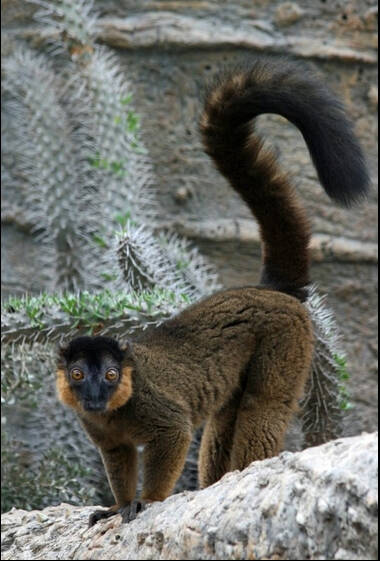Eulemur collaris
IUCN
LCBasic Information
Scientific classification
- name:Eulemur collaris
- Scientific Name:Eulemur collaris,Collared Brown Lemur
- Outline:Primates
- Family:Lemuridae Lemuridae
Vital signs
- length:About 40 cm
- Weight:2.25-2.5kg
- lifetime:About 25 years
Feature
The tail is longer than the body, the snout is fox-like, and the fur is brightly colored.
Distribution and Habitat
The red-collared lemur is found in southeastern Madagascar, from south of the Mananara River to north of Tolagnaro.
The red-collared lemur inhabits tropical moist lowland and montane forests. It is arboreal and spends most of its time in the forest top layer.
Appearance
The red-collared lemur is a medium-sized lemur. It is 39-40 cm long and weighs 2.25-2.5 kg. Its tail is 50-55 cm long, longer than the body, and has dense and long hair, mostly in the shape of a broom. It has large eyes and a dense coat of bright colors. The snout of large species is elongated and shaped like a fox's mouth. The outer ear shell is semicircular or densely furred. The hind limbs are longer than the front limbs, with flat nails on the fingers and toes, and the second toe of smaller species has a grooved and curved claw. It has 36 teeth, but lacks the upper incisors. It can jump considerable distances in a horizontal quadrupedal posture, and its long furry tail helps it maintain balance. The fur color of this lemur is different between males and females. The male has brown-grey fur on the upper body, a darker tail and a pale brown-grey underbody. The forehead and crown are dark slate-grey, which gradually becomes paler as it extends down the back of the neck, becoming
Details
The Red-collared Lemur (scientific name: Eulemur collaris) is also known as Collared Brown Lemur in English. It is a medium-sized lemur.

The Red-collared Lemur lives in small groups of 3 to 12, and a large group of up to 29 individuals has been found. Active at different times throughout the day and night. They feed mainly on fruits, but also on young leaves, flowers, bark, sap, soil, insects, centipedes and millipedes.
As these lemurs move through the jungle, it is not easy to distinguish them from monkeys. These lemurs, which are larger and heavier than their peers, spend more time on the ground. When lemurs jump from trees to the ground to find another tree to live in in order to escape enemies, find food, or for other reasons, the difference between them and monkeys can be clearly seen, because lemurs bend their bodies first and then jump continuously during movement.
The mating season for lemurs is from June to July. The gestation period of female monkeys is 120 days. They give birth from September to November. Usually, they give birth to one baby per litter, and occasionally two babies. The baby monkey is born naked and hairless. The mother monkey either carries the baby on her back or in her arms. The baby will be sexually mature at 1-2 years old. The life span of wild lemurs is 25 years.
Listed in the 2012 Red List of Endangered Species of the World Conservation Union (IUCN) ver 3.1 - Vulnerable (VU).
Protect wild animals and stop eating game.
Maintaining ecological balance is everyone's responsibility!








